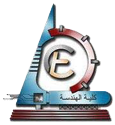Using energy dissipaters on the soled aprons downstream of head structures is the main technique for accelerating hydraulic jump formation and dissipating a great amount of the residual harmful kinetic energy occurring downstream of head structures. In this paper, an experimental study was conducted to investigate some untested shapes of curved dissipaters with different angles of curvature and arrangements from two points of view. The first is to examine its efficiency in dissipating the kinetic water energy. The second is to examine the most effective shape and arrangement obtained from the aforementioned step in enriching the flow with dissolved oxygen for enhancement of the irrigation water quality. The study was held in the irrigation and hydraulic laboratory of the Civil Department, Faculty of Engineering, Assiut University, using a movable bed tilting channel 20 m long, 30 cm wide, and 50 cm high, using 21 types of curved dissipaters with different arrangements. A total of 660 runs were carried out. Results were analysed, tabulated and graphically presented, and new formulas were introduced to estimate the energy dissipation ratio, as well as the DO concentrations. Results in general showed that the dissipater performance is more tangible in dissipating the residual energy when the curvature is in the opposite direction to that of the flow. Also, the energy loss ratio increases with an increase in curvature angle (θ), until it reaches (θ = 120°), then it decreases again. The study also showed that using three rows of dissipaters give nearly the same effect as using four rows, concerning both the relative energy dissipation and dissolved oxygen content. So, it is recommended to use three rows of the curved dissipater with the angle of curvature (θ = 120°) in the opposite direction to that of the flow to obtain the maximum percentage of water energy dissipation downstream of head structures, and maximum dissolved oxygen content too.
Research Member
Research Department
Research Date
Research Year
2015
Research Journal
Limnol. Rev.
Research Publisher
MDPI
Research Vol
15(1)
Research Rank
Q4
Research_Pages
3-14
Research Website
https://doi.org/10.2478/limre-2015-0001
Research Abstract
Research Rank
International Journal

